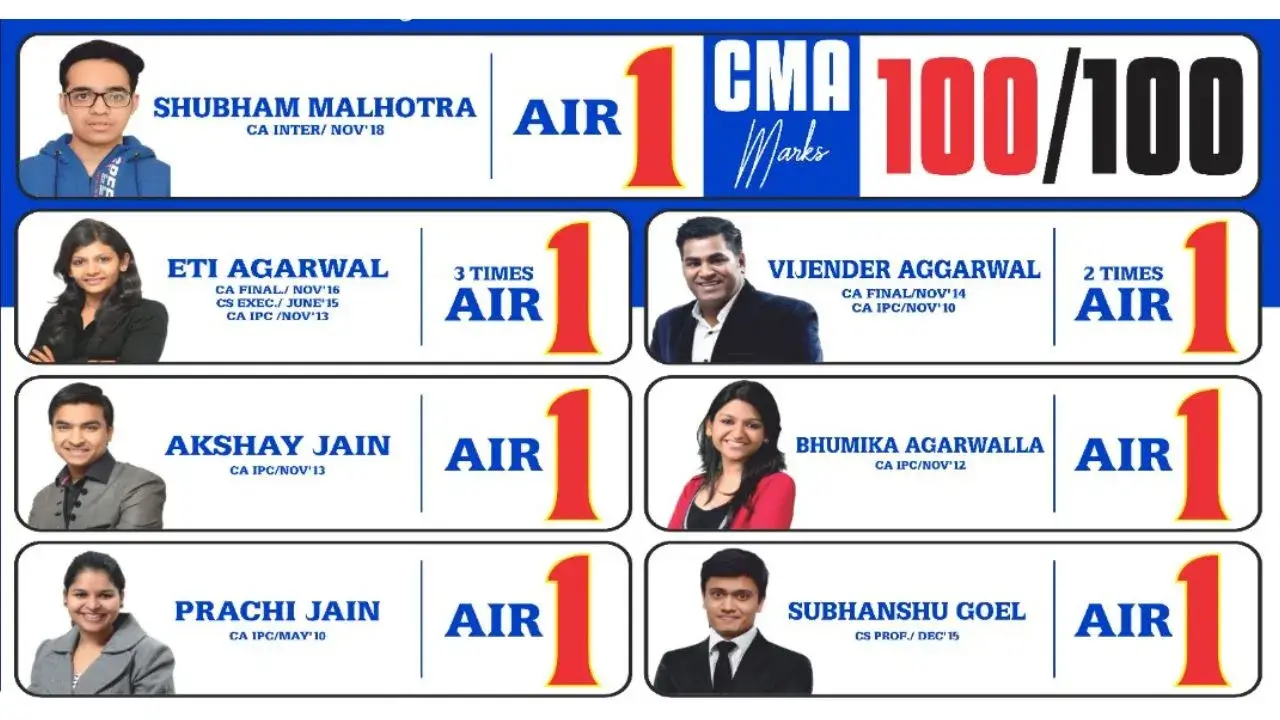CA Intermediate Classes
Online/Offline for January, May, September 2026 Exams
Get More Offers
At IGP Institute, we have been the trusted choice for CA Intermediate classes for over two decades, offering classes in online and offline modes. With a record of producing most top ranks, including 10 times AIR 1, we provide expert CA Inter coaching for all three ICAI attempts—January, May, and September in the new scheme syllabus.
Online Classes Available
26+ Years Experienced Faculty
Free Books & Notes
Our Top Course Lectures
Why IGP for CA Intermediate Classes?
To become a CA, a student goes through diligent efforts. It’s not easy to find the best CA Intermediate coaching classes in both online and offline mode. IGP Classes provides you with a number of benefits and all necessary study material including notes & revision resources that will help you to get success in CA Inter exams.
- Carefully Designed Study Material
- Blended Mode of Learning
- Numerous AIRs and Rank holders
- Friendly Environment for Students
- Personalised Guidance and Mentorship
- Sessions with Industry Experts
- Regular Tests and Revision Classes
Buy CA Intermediate Classes Now
Modes of CA Intermediate Coaching at IGP
| Face to Face/Online/Live at Home | Recorded Pendrive/GD Classes |
|---|---|
| Laxmi Nagar | Rohini | Janakpuri | Buy Now |
IGP CA Inter Coaching Toppers




Subject-Wise Faculties for CA Intermediate Classes
| Subject | Faculty |
|---|---|
| Group 1 | |
| Paper 1: Advanced Accounting | CA Rohit Sethi |
| Paper 2: Corporate & Other Laws | CA Harsh Gupta |
| Paper 3: Taxation | CA Vijender Aggarwal |
| Group 2 | |
| Paper 4: Cost and Management Accounting (Costing) | CA Ashish Kalra |
| Paper 5: Auditing & Ethics | CA Kapil Goyal |
| Paper 6: Financial Management & Strategic Management (FM SM) | CA Ashish Kalra |
Free Demo - CA Intermediate Online Classes
We provide detailed explanation of the subject matter and cover all the essential information that a student needs in CA Intermediate online classes as well as offline classes, have a look!
CA Inter Costing Classes
Cost Management Accounting (CMA)
Available in Online & Offline
CA Inter FM-SM Classes
Financial Management & Strategic Management
Available in Online & Offline
CA Inter Adv. Accounting Demo Class
Adv. Accounts
Available in Online & Offline
CA Inter Law Demo Class
Corporate Laws and Other Laws
Available in Online & Offline
CA Inter Tax Demo Class
Taxation (Income Tax + GST)
Available in Online & Offline
CA Inter Audit Demo Class
Auditing and Ethics
Available in Online & Offline
One distinguishing feature of the CA Intermediate course is its focus on building a strong foundation in both theoretical concepts and practical application. The curriculum is designed to expose candidates to real-world scenarios, enhancing their ability to analyze and solve complex financial problems.
Additionally, the CA Intermediate course places emphasis on professional ethics and values, aligning future Chartered Accountants with the ethical standards expected in the field. This holistic approach ensures that individuals completing the Intermediate level are not only academically proficient but also equipped to handle the ethical challenges that may arise in their professional career.
Advantages of CA Inter Online Classes at IGP
Flexible Learning Schedule
Our CA Inter online classes offer a flexible learning schedule, allowing you to study at your own pace and convenience. With recorded sessions available, you can revisit lectures anytime for thorough revision.
Expert Faculty and Interactive Sessions
Learn from the best with our expert faculty delivering live, interactive sessions online. Our instructors provide personalized attention, ensuring that every student understands the concepts thoroughly.
Comprehensive Study Materials
Access extensive study materials and practice tests online. Our resources are designed to cover the entire CA Intermediate syllabus, helping you prepare effectively for your exams.
Enhanced Accessibility
With our CA Inter online classes, you can study from anywhere, eliminating the need for travel and allowing you to focus more on your studies. Enjoy seamless learning with our user-friendly online platform.
CA Intermediate Exam Eligibility for 2026 exams
The candidates can register for the intermediate course through the following two routes:
- Through CA Foundation Course: Candidates who have qualified CA Foundation Examination conducted by the Institute of Chartered Accountants of India (with minimum 50% marks) to register online /offline.
- Through Direct Entry Route:The following candidates are allowed to directly register online or offline for the CA Intermediate course:
- A Commerce graduate/ Post-Graduate (with minimum 55% marks) or Other Graduate/ Post-Graduate ( with minimum 60% marks)
- A candidate who has passed the Intermediate level exam conducted by the Institute of Company Secretaries of India or the Institute of Cost Accountants of India.
CA Intermediate Registration Date 2025 & 2026
| Exam Attempt | Registration Last Date |
|---|---|
| January 2026 | 1st May 2025 |
| May 2026 | 1st September 2025 |
| September 2025 | 1st February 2025 |
| September 2026 | 1st February 2026 |
CA Intermediate Registration Fees 2025 & 2026
| Fee Description | Indian Nationals | Foreign Nationals |
|---|---|---|
| CA Intermediate Registration Fee | Both Groups: ₹15,000, Single Group: ₹11,000 | Both Groups: $1,000, Single Group: $600 |
| Student’s Activity Fee (One-Time Payment) | ₹2,000 | – |
| CA Intermediate Registration Fee (as article assistant) | Both Groups: ₹1,000, Single Group: - | – |
| Cost of Prospectus (Direct Entry Students) | ₹200 | $20 |
| CA Intermediate Exam Form Fee | Both Groups: ₹2,700, Single Group: ₹1,500 | Both Groups: $500, Single Group: $325 |
| Total CA Intermediate Fee | Both Groups: ₹20,900, Single Group: ₹14,700 | Both Groups: $1,520, Single Group: $945 |
Exam Pattern for Jan, May, Sep 2026
Group 1 Paper Breakdown:
| Paper | Marks | Question Type |
|---|---|---|
| 1: Advanced Accounting | 100 Marks | MCQs: 30 Marks, Descriptive: 70 Marks |
| 2: Corporate & Other Laws | 100 Marks | MCQs: 30 Marks, Descriptive: 70 Marks |
| 3: Taxation | 100 Marks | MCQs: 30 Marks, Descriptive: 70 Marks |
Group 2 Paper Breakdown:
| Paper | Marks | Question Type |
|---|---|---|
| 4: Cost & Management Accounting (CMA) | 100 Marks | MCQs: 30 Marks, Descriptive: 70 Marks |
| 5: Auditing & Ethics | 100 Marks | MCQs: 30 Marks, Descriptive: 70 Marks |
| 6: Financial Management & Strategic Management (FM SM) | 100 Marks | MCQs: 30 Marks, Descriptive: 70 Marks |
CA Intermediate Exam Course Syllabus for Jan, May, Sep 2025 & 2026
As described, the 6 subjects of CA Intermediate course are divided into 2 groups-
Group 1- Advanced Accounting + Corporate and other laws + Taxation
Group 2- Cost and management accounting + Auditing and ethics + Financial and strategic management
Objective - To acquire the ability to apply specific accounting standards and legislations to different transactions and events and in preparation and presentation of financial statements of various business entities.
- Chapter 1: Introduction to Accounting Standards
- Chapter 2: Framework for Preparation and Presentation of Financial Statements
- Chapter 3: Applicability of Accounting Standards
- Chapter 4: Presentation & Disclosures Based Accounting Standards
- Chapter 5: Assets Based Accounting Standards
- Chapter 6: Liabilities Based Accounting Standards
- Chapter 7: Accounting Standards Based on Items Impacting Financial Statement
- Chapter 8: Revenue Based Accounting Standards
- Chapter 9: Other Accounting Standards
- Chapter 10: Accounting Standards for Consolidated Financial Statement
- Chapter 11: Financial Statements of Companies
- Chapter 12: Buyback of Securities
- Chapter 13: Amalgamation of Companies
- Chapter 14: Accounting for Reconstruction of Companies
- Chapter 15: Accounting for Branches including Foreign Branches
Objective - To develop an understanding of the legal provisions and acquire the ability to analyse and apply the laws in practical situations.
PART I - COMPANY LAW AND LIMITED LIABILITY PARTNERSHIP LAW
- Chapter 1: Preliminary
- Chapter 2: Incorporation of Company and Matters Incidental Thereto
- Chapter 3: Prospectus and Allotment of Securities
- Chapter 4: Share Capital and Debentures
- Chapter 5: Acceptance of Deposits by Companies
- Chapter 6: Registration of Charges
- Chapter 7: Management & Administration
- Chapter 8: Declaration and Payment of Dividend
- Chapter 9: Accounts of Companies
- Chapter 10: Audit and Auditors
- Chapter 11: Companies Incorporated Outside India
- Chapter 12: The Limited Liability Partnership Act, 2008
PART II - OTHER LAWS
- Chapter 1: The General Clauses Act, 1897
- Chapter 2: Interpretation of Statutes
- Chapter 3: The Foreign Exchange Management Act, 1999
This paper is divided into two sections - Income Tax and Goods and Services Tax.
Objective - To develop an understanding of the provisions of Income-tax Law and GST Law and acquire the ability to apply such provisions to solve problems and address application-oriented issues.
Section A: Income-tax Law
- Chapter 1: Basic Concepts
- Chapter 2: Residence and Scope of Total Income
- Chapter 3: Heads of Income
- Chapter 4: Income of Other Persons included in Assessee’s Total Income
- Chapter 5: Aggregation of Income, Set-Off and Carry Forward of Losses
- Chapter 6: Deductions from Gross Total Income
- Chapter 7: Advance Tax, Tax Deduction at Source and Tax Collection at Source
- Chapter 8: Provisions for filing Return of Income and Self Assessment
- Chapter 9: Income Tax Liability – Computation and Optimisation
Section B: Goods and Services Tax
- Chapter 1: GST in India – An Introduction
- Chapter 2: Supply under GST
- Chapter 3: Charge of GST
- Chapter 4: Place of Supply
- Chapter 5: Exemptions from GST
- Chapter 6: Time of Supply
- Chapter 7: Value of Supply
- Chapter 8: Input Tax Credit
- Chapter 9: Registration
- Chapter 10: Tax Invoice; Credit and Debit Notes
- Chapter 11: Accounts and Records
- Chapter 12: E-Way Bill
- Chapter 13: Payment of Tax
- Chapter 14: Tax Deduction at Source and Collection of Tax at Source
- Chapter 15: Returns
Objective - To develop an understanding of the basic concepts and applications to establish the cost associated with the production of products and provision of services and apply the same to determine prices and to develop an understanding of cost accounting statements.
- Chapter 1: Introduction to Cost and Management Accounting
- Chapter 2: Material Cost
- Chapter 3: Employee Cost and Direct Expenses
- Chapter 4: Overheads – Absorption Costing Method
- Chapter 5: Activity Based Costing
- Chapter 6: Cost Sheet
- Chapter 7: Cost Accounting Systems
- Chapter 8: Unit & Batch Costing
- Chapter 9: Job Costing
- Chapter 10: Process & Operation Costing
- Chapter 11: Joint Products and By Products
- Chapter 12: Service Costing
- Chapter 13: Standard Costing
- Chapter 14: Marginal Costing
- Chapter 15: Budgets and Budgetary Control
Objective - To develop an understanding of the concepts in auditing and of the generally accepted auditing procedures, techniques and skills and acquire the ability to apply the same in audit and attestation engagements.
- Chapter 1: Nature, Objective and Scope of Audit
- Chapter 2: Audit Strategy, Audit Planning and Audit Programme
- Chapter 3: Risk Assessment and Internal Control
- Chapter 4: Audit Evidence
- Chapter 5: Audit of Items of Financial Statements
- Chapter 6: Audit Documentation
- Chapter 7: Completion and Review
- Chapter 8: Audit Report
- Chapter 9: Special Features of Audit of Different Type of Entities
- Chapter 10: Audit of Banks
- Chapter 11: Ethics and Terms of Audit Engagements
This paper is divided into two sections - Financial Management and Strategic Management.
Objective - To develop an understanding of various aspects of Financial Management and acquire the ability to apply such knowledge in decision-making, and to understand various finance functions like financing, investment, dividend decisions, and develop understanding of strategic management concepts and apply them in business situations.
Section A: Financial Management
- Chapter 1: Scope and Objectives of Financial Management
- Chapter 2: Types of Financing
- Chapter 3: Financial Analysis and Planning – Ratio Analysis
- Chapter 4: Cost of Capital
- Chapter 5: Financing Decisions – Capital Structure
- Chapter 6: Financing Decisions – Leverages
- Chapter 7: Investment Decisions
- Chapter 8: Dividend Decision
- Chapter 9: Management of Working Capital
Section B: Strategic Management
- Chapter 1: Introduction to Strategic Management
- Chapter 2: Strategic Analysis: External Environment
- Chapter 3: Strategic Analysis: Internal Environment
- Chapter 4: Strategic Choices
- Chapter 5: Strategy Implementation and Evaluation
CA Intermediate Admit Card
As we know that CA Intermediate examinations will commence from Sep so admit cards will be available on the official website of ICAI. All the candidates can download admit cards from the official website by using their registration number and password.
CA Intermediate Results
ICAI will release the CA Intermediate exam results within a month or two after the exams are conducted.
Frequently Asked Questions - CA Inter Classes
One of the foremost thing required for a CA Intermediate student is that he/she needs to make a proper study plan/timetable for self because that will help him/her to stay focused and disciplined and also keep track of the syllabus. Rest he/she needs to practice regularly, indulge in workout and meditation, daily revision and stay positive.
In order to become a rank holder, you should work upon on writing and presentation skills where quoting certain sections appropriately can fetch you additional marks and always try to make your own notes while study, that will help you to revise and regularly analysing your performance through mock tests is a great way to rectify where you are going wrong.
Our CA Intermediate online classes offer flexibility, convenience, and access to expert faculty and comprehensive study materials from anywhere.
Now with 30 marks of MCQs with no negative marking, the level of CA Intermediate exams has become easier and with ICAI’s approach towards including more and more practical concepts and case studies in the syllabus, CA Intermediate has become more scoring than before.
Promptly, IGP Classes is the best coaching classes for CA Intermediate. With 25+ years of experience, 95% Student Success Rate, Finest Faculty, Meet and Greets with Industry Experts and Top Notch Classroom Environment, IGP Classes stands unbeatable in this field.
Studying without a proper plan, not making efforts in presenting the answer, consulting with too many people, not doing enough practice, spending a lot of time on social media and most importantly constantly comparing yourself with your peers.
Undoubtedly, IGP Classes is the best for CA Intermediate online coaching classes. Studying online has its own limitations that teachers are not present physically, no quick doubt resolutions etc but with IGP Classes you can sure of the services provided as we have a Dedicated Technical Support, Live chat options for students, Quick Query Resolutions and Direct Faculty Access.
Registration for Intermediate exams begin from April (Previous Year) for January (Current Year) attempt, August (Previous Year) for May (Current Year) Attempt, and December (Previous Year) for September (Current Year) Attempt.
Go to the official website of ICAI- www.icai.org and fill out the form with all necessary details and submit the documents. Pay the fees and your registration is completed..
There will be 30% case based MCQs and 70% descriptive questions in all six papers of Intermediate Exams.
If a student has appeared in all the papers in a Group and fails in one or more papers but secures a minimum of 60% marks in any paper, he/she shall be exempted for that paper in which he/she has secured 60% or more marks for the immediately next three following examinations. The student will be required to obtain a minimum of 40% marks in each of the remaining papers and a minimum of 50% marks in the aggregate of all the papers including the exempted paper to pass the Group.
What Our Students
Say About Us
“ Scored 100/100 in CMA and couldn’t have achieved it without Ashish sir. I used to keep contacting him regarding my doubts and at times when I was tensed. He used to be always there for me to guide ... “
Muskan Vadhera-CMA Marks 100/100
“ "It's a matter of great pride for me to achieve these goals and in reaching these milestones, IGP played a very important role for me. Be it CPT, IPC or Final, at all the levels all the faculty prov... “
Pragati Varshney-AIR-7-CFM Marks 94/100
“ "The experience of those 5 months with CA Ashish Kalra Sir was a life transforming journey. The main thing that is required in CA exams is Conceptual understanding. Sir's classes were a perfect blen... “
Shubham Agarwal-AIR-5
“ "The first coaching that I took was Cost and FM. It was a really great experience with sir. Everyday we came, the class comprised half of learning and half of motivation. We always had our fire burn... “
Aekansh Jain-AIR-4
“ "Teaching at its very best is what describes CA Ashish Kalra sir and CA Vijender Aggarwal sir. They both are extraordinary teachers. Their teaching style makes them stand out among others. They put ... “
AISHNIT KAUR-AIR-4
“ I feel lucky that I got chance to be taught by CA Ashish Kalra Sir. To attend his class was quite a fabulous experience for me. He is the best teacher, mentor and guide I have ever seen. He makes ever... “
Pramanshu Sharma-AIR-3-CFM MARKS 88/100
“ I am Abhishek Agarwal, I secured All India 2nd rank in the CA-IPCC Nov’15 exams and got 82 marks in CFM. Talking about CA Ashish Kalra Sir I think he is a person who not only possesses the most... “
Abhishek AgarwaL-AIR-2-CFM Marks 82/100
“ It was an amazing experience attending Kalra sir's classes. A great extent of this achievement of mine is owed to sir. The flawlessness of his teaching and the passion with which he teaches are someth... “
Bhumika Agarwalla-AIR-1-CFM Marks
“ The experience of taking classes from CA Ashish Kalra Sir was amazing. He is the most hardworking person I have ever seen. The positivity and energy level which he passes to his students is simply a... “
Shubham Malhotra-AIR-1-CMA Marks 100/100
“ Ashish Kalra Sir has an impeccable talent of bringing the best out of his students. Further his questioning attitude and the method of developing the concepts is something which not only makes the sub... “
Vijender Aggarwal - 2 Times AIR-1
“ It has been a great expereince studing CMA & FM Eco from you Ashish Sir. I am so lucky that I got a teacher like you. Your teaching method is really simple, straight forward and effective and I will n... “
Shivam Malhotra
“ The great instiute, where students are empowerd with knowledge and wisdom. CA Ashish Kalra Sir is DRONNACHARYA of CA students, in their classes knowledge flows like water is flowing in the river. He w... “
Satpal Singh
“ Give your best and you will definitely get the best. Keep on working hard and you will clear your CA Exams with good marks. This is what I did. I make a schedule and tried to follow it. Sir always use... “
Prachi Jain
“ Sir… you are the best teacher no one can teach Cost, FM & ECO for finance better than you….. This whole market is full of teachers but you are diamond of the field and your book of economi... “
Nikhil Arora
“ Ashish sir is the one who takes a hand opens a mind and touches the heart. He is the best inspiration one can get He is the best teacher one can get. ... “
Neha Tayal
“ Sir, you have been an excellent teacher, hardworking and devoted to your work and to us. You have helped us grasp your subject through intresting lectures and presentations, feeling us up to achieve o... “
Mittul Garg
“ The experience of taking classes from Ashish Sir is magical, something that cannot be accurately described in words. Although I took a pendrive classes, I never felt disconnected and it was as if I wa... “
Mahin Naim
“ Ashish Kalra Sir, You are the Best, I still remember before the first day of class when everything was new and tough in my mind, since the first day till the last day everything was easy as a cakewalk... “
Ishita
“ Ashish Kalra Sir YOU ARE THE BEST, I still remember the first day of class when all questions seemed same and confusing to me and last day when I was able to handle them proficiently. You made CMA lik... “
Isha
“ The Ashish Kalra Sir u have been so much more than a teacher for us…. (mentor, guide, friend) I can challenge anybody in the whole world to find a better teacher than u…. U have set a grea... “
Himanshi Goel
“ Words are too little to express what you are to me. You are the most invaluable part of my life and play multiple roles. But it was a teacher that you first exercised your influence on me. So on the o... “
ETI Agarwal
“ Choosing Ashish Sir as mentor was one of the decisions I am proud of, beside his extreme knowledge and ability to disseminate it, his hardwork for us was indeed selp motivating. Now to elobrate on stu... “
DUSHYANT GARG
“ Best faculty for CA and only institute with face to face classes. Energy level is so high. Motivational lectures are awsome. Best books and content fully covered. Fun and knowledge together. ... “
AMAN SAXENA
“ Ashish sir apke jaisa teacher kabhi nahi mila aur shayad kabhi milega bhi nahi. Sir u r the best…... And apke concept batane ki technique is simply awsome. According to my family and friends I c... “
ANKIT KUMAR
“ Sir ji…. Apne Economics, FM, Cost itni easy tarah se padhaya ki sab samajh aa gya... Sir I Love You… you are the best teacher of this world thanks sir ji for this. ... “
ANSHUL VASHISTHA
“ Sir apke padhane ka tarika is out of level full conceptual clearity milti hai and theory padhane ka itna interesting way hai ki kabhi bore nahi hote…... Thanks for all such efforts you do for us... “
ANUBHAV THAKUR
“ I Scored 80 marks in SFM in yesterday result and I am a CA now so thanku sir for your guidance and effort.... “
ANURAG ARORA
“ I was not able to clear only SCMPE for the last 2 times. But this time because of your classes, I crack it and become CA. Thanks a lot sir... “
ARPIT
“ Ashish sir is the best teacher anyone can get…. The way he teaches the concepts and clear each and every doubt is just amazing….. Studing Costing and FM from Ashish sir is just blessing ... “
Divya Jain
“ it was a great experience studing from Ashish Sir. He always motivated us to give our best. He focused on concepts which really helped me in my revisions. His books are more than sufficient for exams ... “
DIVIJ CHADHA
“ Ashish Sir is an amazing teacher. The way he introduces us with a concept, it make sure we never forget it. He has an explanation for every part of a concept, you just have to be a tentive and never g... “
ANSHIKA GOEL
“ Experience of those four months with Ashish Kalra Sir was out of the world. A person who possesses such vast knowledge not only in the field of cost & F.M. but in other fields also, that we can dream ... “
AKSHAY JAIN
“ IGP is a place you can trust. I am very happy to be a part of this institute. CA Ashish Kalra is a great teacher and I am so blessed to be a part of his life which he shared with us while teaching us.... “
VISHAL KAPOOR
“ You are an awesome teacher by the way you teach. Your hard work to build our careers motivates us to work more till our last breath. You taught us not just Cost and FM, but also about all life aspects... “
HEMANT AGGARWAL
“ The most important thing that I've learnt is to plan my work. ASHISH SIR has been a constant source of motivation who instills a lot of confidence in a person. I actually started believing, that achie... “
SASHA AGGARWAL
“ ASHISH KALRA SIR, the most hardworking and sincere teacher I’ve ever met. IGP means awesome and the best institute for CA classes. I believe all my success is because of this hardworking teache... “
ABHISHEK BHARTI
“ Sir, you are really awesome. I have never met you personally but ek ajeeb sa mental connection ho gaya hai aapse. I am taking your satellite classes in Agra. I can't even imagine what would be the sit... “
PARAS KALRA
“ Thank you sir, for converting our mistakes into lessons, pressures into productivity and skills into strength. You really know how to bring out the best in us. You are the answer to all our problems a... “
PRIYANSHI GARG
“ As the name suggests, IGP is an institute that really grooms professionals in true manner. Experience is not something which can be defined in words. It is a feeling and the feeling here at IGP with A... “
SHIVAM GOEL
“ Having studied from Ashish Kalra sir in IPCC, I was absolutely sure to take my classes from him for CA Final too. The way he teaches the concepts, they get deeply engraved in us in a manner that it's ... “
MANVI DHINGRA






Our Achievements
250000
Students Enrolled
200
Top Class Products
1000+
Ranks
10
AIR 1









